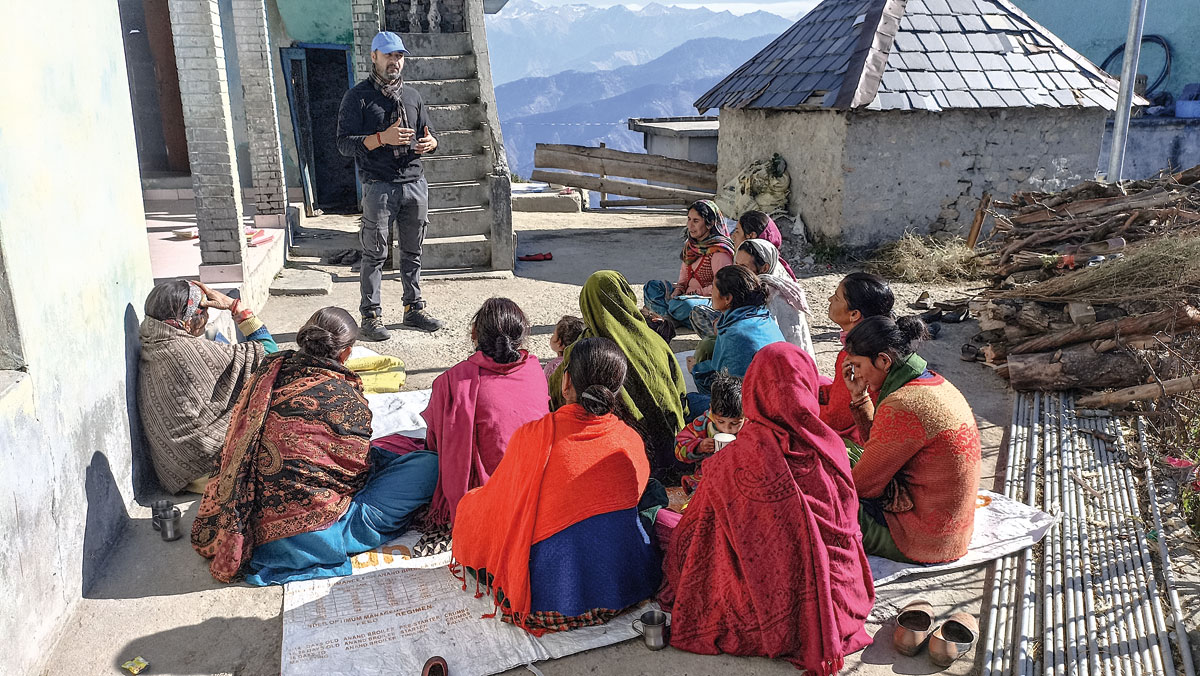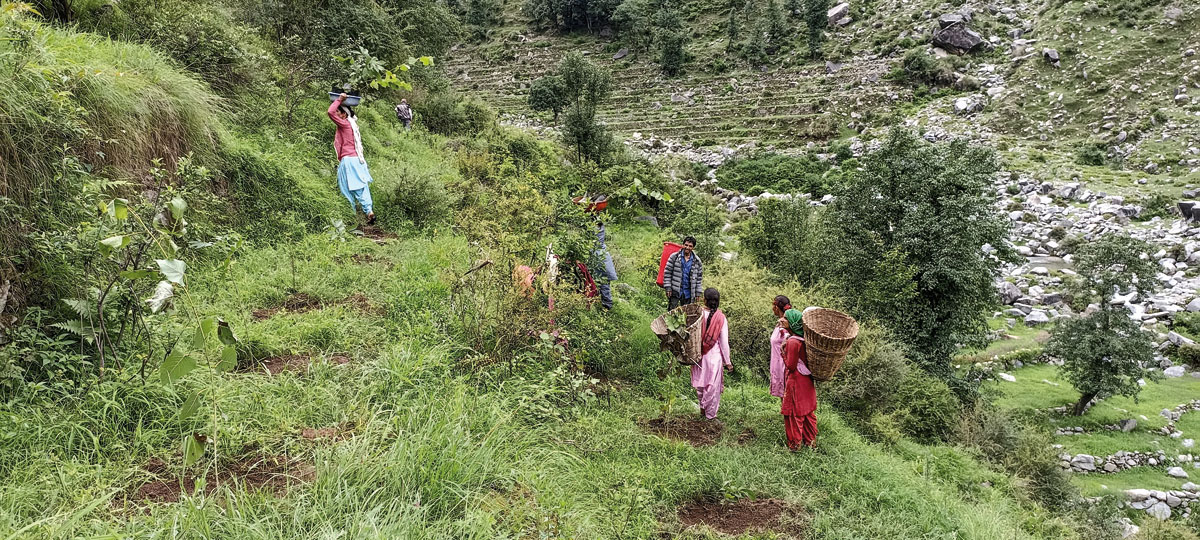A Rewilding Journey In Chamba
First published in Sanctuary Asia,
Vol. 43
No. 10,
October 2023
By Neyi Jamoh (with inputs from Vishal Ahuja)
Enamoured by the trees, wildlife and forests surrounding his Chamba Valley home since a young age, after obtaining a Master’s degree in Botany in 2011, Himachal Pradesh resident Vishal Ahuja followed his passion for conservation and joined a study on the distribution of the Himalayan grey langur (also known as the Chamba sacred langur). The project involved mapping human-wildlife conflict zones, and documenting conservation challenges in Chamba.
This study, which was conducted in 2012 by Vishal and his team under the guidance of Dr. Sanjay Molur (Executive Director, Zoo Outreach Organisation; Founder Secretary, Wildlife Information Liaison Development Society, Coimbatore), heralded the birth of a rewilding project aimed at fostering human-animal coexistence in the Chamba Valley.

Since 2020. Vishal has been interacting with several members of the local community to garner support for the rewilding project in Chamba. Here Vishal is seen speaking to a group of farmers at Kakela village, Chamba District, Himachal Pradesh. Photo Courtesy: Vishal Ahuja.
The Ground Work
A majority of communities living on the fringes of the Kalatop Khajjiar Wildlife Sanctuary in Himachal Pradesh are farmers. Over the years, with the extension of farming areas, uncontrolled grazing by cattle, and unsustainable use of forest-based resources, coupled with climate change, the pine-oak mixed forests near villages were severely degraded. In 2014, a follow-up study in 12 highly conflict-prone villages surrounding the wildlife sanctuary helped the team understand local people’s perception of crop depredation and loss, and helped document possible ways to mitigate human-animal conflict (as suggested by locals). Two related studies conducted by Vishal in February-March in 43 villages and in 53 villages in November-December in 2016 revealed that wildlife such as Himalayan black bears, rhesus macaques, Himalayan grey langurs, and porcupines caused farmers to lose a major portion (57.17 per cent) of their expected yield to depredation, a fact that explains the presence of several abandoned terraced farms. During the questionnaire survey, Vishal and his team also learned that encounters with Himalayan black bears had turned fatal for a few locals, aggravating the atmosphere of fear of and ill-will against certain wildlife species in the region.
Putting Two And Two Together
Empowered by these findings, the team asked basic but relevant questions in this context, such as, why wild animals risk their lives to feed on crops when they have ample food in the forest. Between 2017 and 2019, Vishal compared the floral diversity and distribution within the wildlife sanctuary to that of the fragmented forest patches around villages. Additionally, his documentation of the diet preference of the Chamba sacred langur and other wildlife led to the understanding that a) wildlife visited farmlands in search of food resources, and b) degraded habitats within fragmented forests do not harbour sufficient stock of native flora that form the diet of several wildlife species. These findings further helped unravel the obvious but seemingly-elusive point – that the availability of native flora that forms the food base of wildlife is crucial to maintaining a healthy human-wildlife relationship in Chamba.
Rewilding Is A Social And Ecological Process
Based on the learnings of over eight years of scientific studies, constant interactions with locals, and countless field visits, Vishal’s team was convinced that restoring native flora within severely degraded and fragmented forest patches was one of the most important steps to mitigating human-wildlife negative interactions in Chamba. It made sense to approach the issue in a manner close to nature’s ways of working – restoring in a slow yet deliberate manner to restock native flora for the region’s wildlife.
At the start of his rewilding initiative in 2020, Vishal conducted one-on-one interviews with locals, sharing details about his long-term project. Most of his days were spent reconciling people’s hesitations and gaining acceptance for non-local volunteers, who would eventually work on the project in the coming months. Two years into the project, Vishal has learned that saplings planted on privately-owned lands survive and grow better than those planted on open forest lands, where care and protection against grazing by livestock are lacking. Further reiterating the importance of community support, he also observed that local support helped reduce project costs for plant protectors. “At a time when locals were continuing to incur economic loss on account of depredation and facing fatal attacks from wild animals, convincing them to save wild animals and forests was not easy. However, with consistent efforts and outreach, many people now understand the root cause of the problem and have begun to accept rewilding as a possible solution,” says Vishal.
Additionally, camaraderie with the Chamba Forest Department by actively participating in departmental-led activities such as annual bird counts enabled Vishal to push for a research-based approach to rewilding degraded forests. In October 2022, after two years of planning based on field conditions, keeping up with the Forest Department’s schedules, and perseverance on Vishal’s part, he led a 21-member team, conducting the first-of-its-kind census of the Himalayan grey langur. This will strengthen long-term conservation plans for the shy endemic primate, which will, in turn, impact the approaches of the rewilding projects he leads.

With the support and participation of local farmers, over 800 saplings of native species were planted at the Rathiyar Panchayat in the monsoon season of 2022. Photo Courtesy: Vishal Ahuja.
Rewilding Chamba – A work In Progress
Just as the process of rewilding is a slow but deliberate one, the journey of choosing rewilding as the suitable conservation approach for a region should be intentional and gradual, and based on sound science. Vishal’s experience underscores that winning local community support and participation is essential to the success of long-term rewilding endeavours. Also, that this entails reworking plans based on field conditions and community sentiments, as well as winning the cooperation of the local Forest Department.
Vishal has also focused on keeping up with the latest research and rewilding approaches to successfully build a well-informed rewilding plan for his home valley. In June 2022, he spent 20 days working with and learning from experts at the Nature Conservation Foundation, in Valparai (Tamil Nadu), Pondicherry’s Pitchandikulam forest, and in the Nilgiri Biosphere Nature Park at Anaikatti. Here he gleaned invaluable learnings on how to restore degraded forests and raise nurseries of native plants.
Between 2020 and 2022, supported by Sanctuary’s Mud on Boots Project and the active participation of local farmers from Rathiyar Panchayat, Vishal carefully oversaw the plantation of over 1,500 saplings of native trees on degraded forests and abandoned terrace farms.
In January 2023, with funding from the Astral Foundation, Vishal leased an area of 752 sq. m. at Dugli village, thus fulfilling his decade-long dream of establishing a functional nursery of native plants. Here, using his knowledge of the ecology of local flora, Vishal and his team successfully raised 1,600+ saplings from seeds and cuttings. “I work at the nursery to raise local species of saplings to plant in degraded forests as food for wildlife. I expect that, eventually, our crops will be saved from depredation as wildlife will have access to their food,” said Shakti Pal, a farm owner who is permanently employed at the nursery.
The Road Ahead
Since 2020, Vishal has doggedly led all aspects of the rewilding project in Chamba. With support from the Mud on Boots Project, mentored by Dr. Sanjay Molur, he is exploring more funding opportunities to run the nursery. His work currently focuses on the Rathiyar Panchayat, but he hopes to take on additional areas over the next five years, with support from community members and in collaboration with the District Administration as well as the Forest Department.
In the final analysis, individuals such as Vishal can and will make a difference because they believe viscerally that working with nature will improve the lives of people and the wild species with which their lives are entwined.



